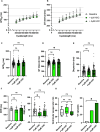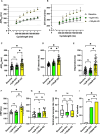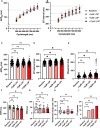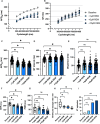Electrophysiological Profile of Different Antiviral Therapies in a Rabbit Whole-Heart Model
- PMID: 38851664
- PMCID: PMC11211193
- DOI: 10.1007/s12012-024-09872-3
Electrophysiological Profile of Different Antiviral Therapies in a Rabbit Whole-Heart Model
Abstract
Antiviral therapies for treatment of COVID-19 may be associated with significant proarrhythmic potential. In the present study, the potential cardiotoxic side effects of these therapies were evaluated using a Langendorff model of the isolated rabbit heart. 51 hearts of female rabbits were retrogradely perfused, employing a Langendorff-setup. Eight catheters were placed endo- and epicardially to perform an electrophysiology study, thus obtaining cycle length-dependent action potential duration at 90% of repolarization (APD90), QT intervals and dispersion of repolarization. After generating baseline data, the hearts were assigned to four groups: In group 1 (HXC), hearts were treated with 1 µM hydroxychloroquine. Thereafter, 3 µM hydroxychloroquine were infused additionally. Group 2 (HXC + AZI) was perfused with 3 µM hydroxychloroquine followed by 150 µM azithromycin. In group 3 (LOP) the hearts were perfused with 3 µM lopinavir followed by 5 µM and 10 µM lopinavir. Group 4 (REM) was perfused with 1 µM remdesivir followed by 5 µM and 10 µM remdesivir. Hydroxychloroquine- and azithromycin-based therapies have a significant proarrhythmic potential mediated by action potential prolongation and an increase in dispersion. Lopinavir and remdesivir showed overall significantly less pronounced changes in electrophysiology. In accordance with the reported bradycardic events under remdesivir, it significantly reduced the rate of the ventricular escape rhythm.
Keywords: Anitviral; Arrhythmia; Azithromycin; Hydroxychloroquine; Long QT syndrome; Lopinavir; Remdesivir; Sudden cardiac death.
© 2024. The Author(s).
Conflict of interest statement
None.
Figures





Similar articles
-
Concomitant Treatment with Proton Pump Inhibitors and Cephalosporins Does Not Enhance QT-Associated Proarrhythmia in Isolated Rabbit Hearts.Cardiovasc Toxicol. 2020 Dec;20(6):531-538. doi: 10.1007/s12012-020-09577-3. Cardiovasc Toxicol. 2020. PMID: 32500385
-
COVID-19 Drugs Chloroquine and Hydroxychloroquine, but Not Azithromycin and Remdesivir, Block hERG Potassium Channels.J Pharmacol Exp Ther. 2021 May;377(2):265-272. doi: 10.1124/jpet.120.000484. Epub 2021 Mar 5. J Pharmacol Exp Ther. 2021. PMID: 33674391
-
Divergent Electrophysiological Effects of Loperamide and Naloxone in a Sensitive Whole-Heart Model.Cardiovasc Toxicol. 2021 Mar;21(3):248-254. doi: 10.1007/s12012-020-09616-z. Epub 2020 Oct 30. Cardiovasc Toxicol. 2021. PMID: 33125619
-
Insights into antiviral mechanisms of remdesivir, lopinavir/ritonavir and chloroquine/hydroxychloroquine affecting the new SARS-CoV-2.Biomed Pharmacother. 2020 Nov;131:110668. doi: 10.1016/j.biopha.2020.110668. Epub 2020 Aug 24. Biomed Pharmacother. 2020. PMID: 32861965 Free PMC article. Review.
-
A Review of the Preclinical and Clinical Efficacy of Remdesivir, Hydroxychloroquine, and Lopinavir-Ritonavir Treatments against COVID-19.SLAS Discov. 2020 Dec;25(10):1108-1122. doi: 10.1177/2472555220958385. Epub 2020 Sep 17. SLAS Discov. 2020. PMID: 32942923 Free PMC article. Review.
Cited by
-
Electrophysiological and sick sinus syndrome effects of Remdesivir challenge in guinea-pig hearts.Front Physiol. 2024 Aug 13;15:1436727. doi: 10.3389/fphys.2024.1436727. eCollection 2024. Front Physiol. 2024. PMID: 39193439 Free PMC article.
References
-
- Gautret P, Lagier JC, Parola P, Hoang VT, Meddeb L, Mailhe M, et al. Hydroxychloroquine and azithromycin as a treatment of COVID-19: Results of an open-label non-randomized clinical trial. International Journal of Antimicrobial Agents. 2020;56(1):105949. doi: 10.1016/j.ijantimicag.2020.105949. - DOI - PMC - PubMed
Publication types
MeSH terms
Substances
LinkOut - more resources
Full Text Sources

